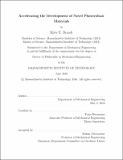| dc.contributor.advisor | Tonio Buonassisi. | en_US |
| dc.contributor.author | Brandt, Riley Eric | en_US |
| dc.contributor.other | Massachusetts Institute of Technology. Department of Mechanical Engineering. | en_US |
| dc.date.accessioned | 2016-09-13T18:08:32Z | |
| dc.date.available | 2016-09-13T18:08:32Z | |
| dc.date.copyright | 2016 | en_US |
| dc.date.issued | 2016 | en_US |
| dc.identifier.uri | http://hdl.handle.net/1721.1/104134 | |
| dc.description | Thesis: Ph. D., Massachusetts Institute of Technology, Department of Mechanical Engineering, 2016. | en_US |
| dc.description | This electronic version was submitted by the student author. The certified thesis is available in the Institute Archives and Special Collections. | en_US |
| dc.description | Cataloged from student-submitted PDF version of thesis. | en_US |
| dc.description | Includes bibliographical references (pages 203-218). | en_US |
| dc.description.abstract | To restrict the warming effects of climate change to less than a 2°C increase, we must deploy terawatts of solar photovoltaics (PV) and other renewables in the next 10-15 years -- yet, historically novel PV materials have taken decades to go from discovery to commercial relevance. In this thesis, several strategies are outlined for faster screening of novel PV materials, including absorber layers and their respective carrier selective contacts, with the goal to reduce the materials development cycles from years to days or weeks through smarter design, modeling, and characterization. First, "smart" theoretical screening criteria are established by considering the electronic structure features that produce tolerance to defects in semiconductors. Data mining a repository of tens of thousands of materials using these insights reveals a class of partially oxidized cation compounds that could offer promising PV properties. A fast experimental protocol is developed to quickly synthesize these materials and evaluate their minority carrier properties. This is then applied to bismuth halides and related compounds, revealing several materials with carrier lifetimes in excess of 1 ns. Next, X-ray photoelectron spectroscopy (XPS) and related tools are used to design and predict optimal electron and hole selective contacts for thin-film PV absorbers. In particular, contacts are designed for cuprous oxide (Cu₂O) and tin monosulfide (SnS), resulting in state-of-the art open-circuit voltages for both materials. These XPS measurements are then compared to temperature- and illumination-dependent electrical measurements on Cu₂O solar cells to achieve comparable precision and accuracy to spectroscopy in a fraction of the time. Finally, new numerical fitting approaches are applied to these electrical measurements in order to infer the underlying materials properties from purely electrical measurements. Using Bayesian inference, fundamental materials properties of SnS and other semiconductors are inferred from electrical measurements, allowing for full quantification of efficiency loss mechanisms in a new solar cell material in the time scale of one day. Together, these results point towards leveraging smarter theory and modeling to accelerate and improve how new PV materials are developed. | en_US |
| dc.description.statementofresponsibility | by Riley E. Brandt. | en_US |
| dc.format.extent | 218 pages | en_US |
| dc.language.iso | eng | en_US |
| dc.publisher | Massachusetts Institute of Technology | en_US |
| dc.rights | M.I.T. theses are protected by copyright. They may be viewed from this source for any purpose, but reproduction or distribution in any format is prohibited without written permission. See provided URL for inquiries about permission. | en_US |
| dc.rights.uri | http://dspace.mit.edu/handle/1721.1/7582 | en_US |
| dc.subject | Mechanical Engineering. | en_US |
| dc.title | Accelerating the development of novel photovoltaic materials | en_US |
| dc.type | Thesis | en_US |
| dc.description.degree | Ph. D. | en_US |
| dc.contributor.department | Massachusetts Institute of Technology. Department of Mechanical Engineering | |
| dc.identifier.oclc | 958149403 | en_US |
